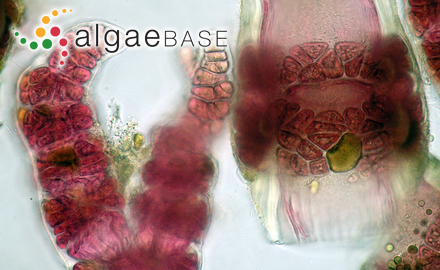Gayliella flaccida (Harvey ex Kützing) T.O.Cho & L.M.McIvor 2008

Current name:
Gayliella flaccida (Harvey ex Kützing) T.O.Cho & L.M.McIvor
cross-section, North of Galicia, Spain, 2015Ignacio Bárbara (barbara@udc.es)
Publication Details
Gayliella flaccida (Harvey ex Kützing) T.O.Cho & L.M.McIvor 2008: 723, fig. 1 A-R
Published in: Cho, T.O., Boo, S.M., Hommersand, M.H., Maggs, C.A., McIvor, L. & Fredericq, S. (2008). Gayliella gen. nov. in the tribe Ceramieae (Ceramiaceae, Rhodophyta) based on molecular and morphological evidence. Journal of Phycology 44: 721-738, 11 figs.
Type Species
This is the type species (holotype) of the genus Gayliella.
Status of Name
This name is of an entity that is currently accepted taxonomically.
Basionym
Hormoceras flaccidum Harvey ex Kützing
Type Information
Type locality: Ad oras britannicas prope Kilkee [Kilkee, Co. Clare, Ireland]; (Kützing 1862: 21) Lectotype: "Harv. in litt." [W.H. Harvey]; L; 940.265.55 (Maggs & Hommersand 1993: 59) Notes: Syntypes: L, BM, TCD.
Origin of Species Name
Adjective (Latin), flaccid, not able to hold up its own weight (Stearn 1983).
General Environment
This is a marine species.
Created: 02 July 2008 by M.D. Guiry.
Last updated: 15 November 2023
Verification of Data
Users are responsible for verifying the accuracy of information before use, as noted on the website Content page.
Taxonomic note
"G. flaccida [based on Hormoceras flaccidum Harvey ex Kützing, a species later combined under the genus Ceramium by Ardissone [1871: 40, as C. flaccidum (Harvey ex Kützing) Ardissone] distinguishes from G. mazoyerae Cho, Fredericq et Hommersand mainly in branching intervals of both main and lateral axes (see the above key), a character ignored before Cho et al.'s (2008) paper. Therefore, it's highly probable that Mediterranean records referred to as Ceramium flaccidum as well to its alleged synonyms C. gracillimum (Kützing) Griffiths et Harvey ex Harvey var. byssoideum Feldmann-Mazoyer [= Gayliella transversalis]; C. gracillimum sensu Harvey [= G. flaccida]; C. masonii E.Y. Dawson [= G. masonii (E.Y. Dawson) Huisman] and C. taylorii E.Y. Dawson [= G. taylorii] (see Gómez Garreta et al. 2001) should be considered as misapplied names for G. mazoyerae. Therefore, at the present state of knowledge, there exist no documented record from the Mediterranen Sea of G. flaccida as circumscribed by Cho et al. (op. cit.). In fact, in the recent Mediterranean records of that species [Sales & Ballesteros (2010: 464, tab. 1) from Catalonia (Spain), Pinedo et al. (2013: 407, tab. 1) from Corsica (France), Taskin et al. (2013; 151, tab. 1) from Turkish part of Cyprus and by Taskin et al. (2019: 23, appendix 1) from the Turkish coast of the Marmara Sea], G. flaccida is simply listed within tables with no comment." Cormaci & al. (2023: 243). - (15 November 2023) - M.D. Guiry
Distributional note
Huisman (2018: 419) notes "... there are numerous Australian records of this species, based on the broad interpretation of Womersley (1979). The eastern Australian record by Price & Scott (1992) described specimens with 4-5 (-7) periaxial cells which appear to be similar to those attributed here to G. transversalis." - (08 October 2018) - M.D. Guiry
Linking to this page: https://www.algaebase.org/search/species/detail/?species_id=133586
Citing AlgaeBase
Cite this record as:
M.D. Guiry in Guiry, M.D. & Guiry, G.M. 15 November 2023. AlgaeBase. World-wide electronic publication, National University of Ireland, Galway. https://www.algaebase.org; searched on 29 March 2025
 Request PDF
Request PDF














